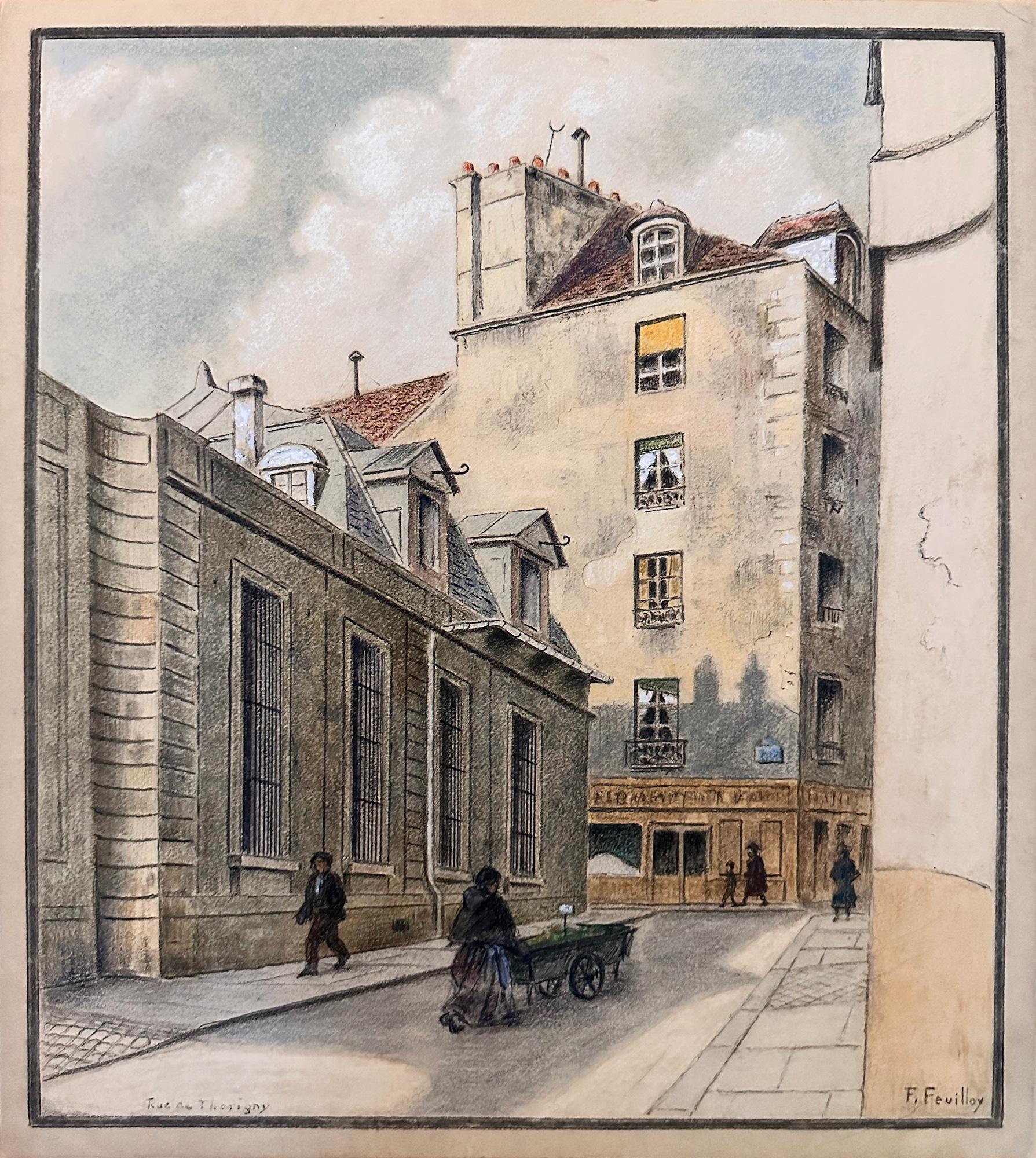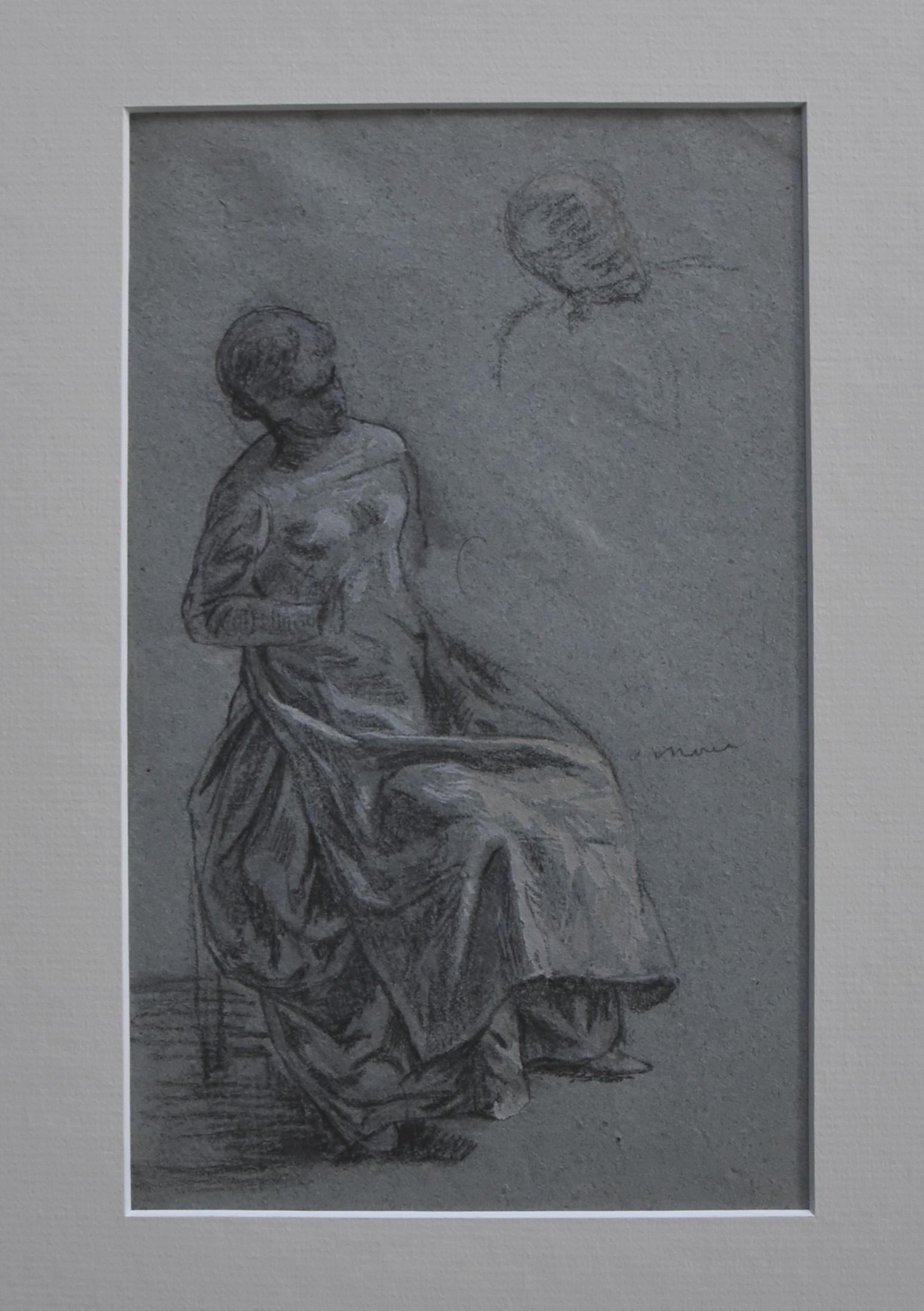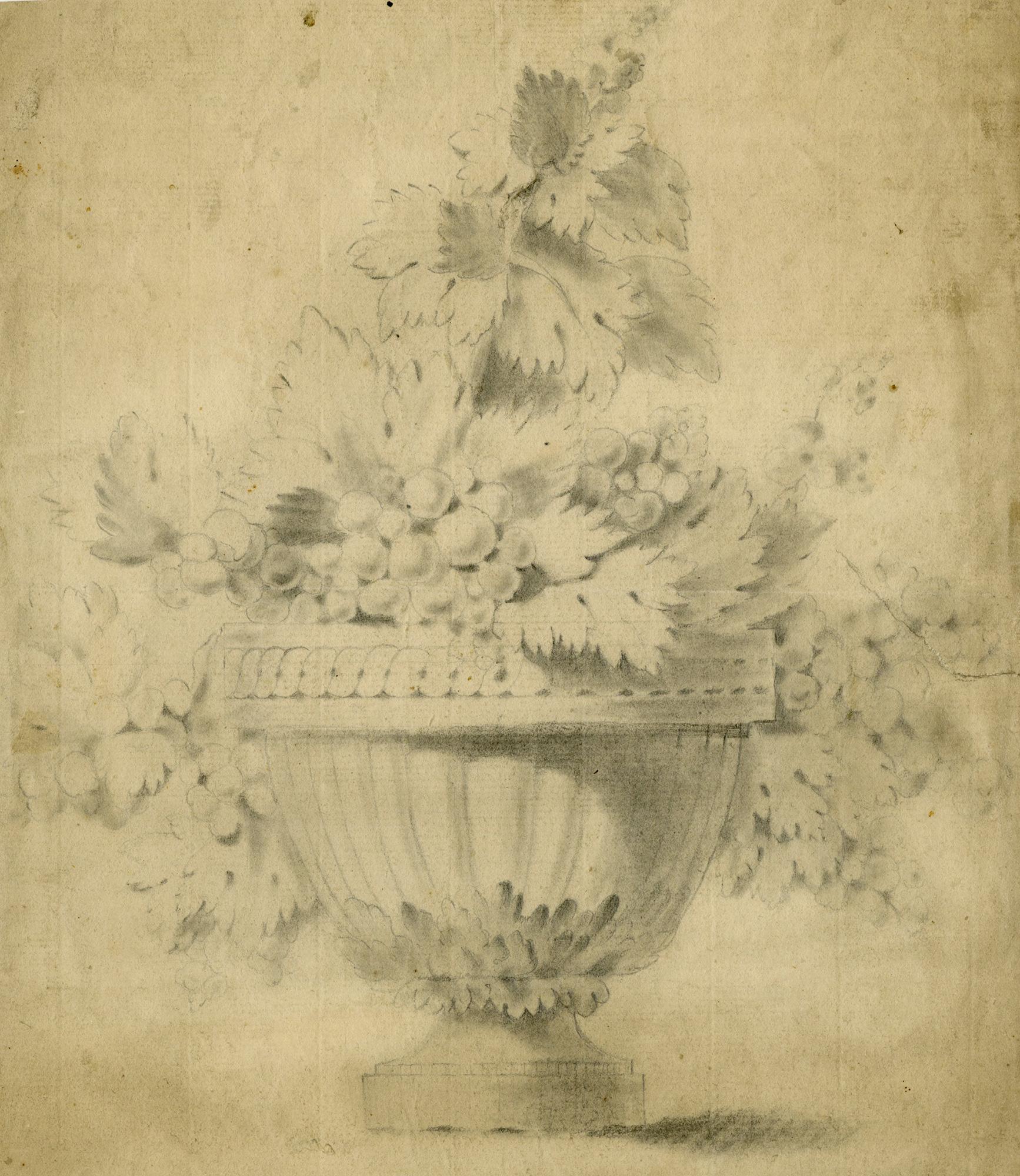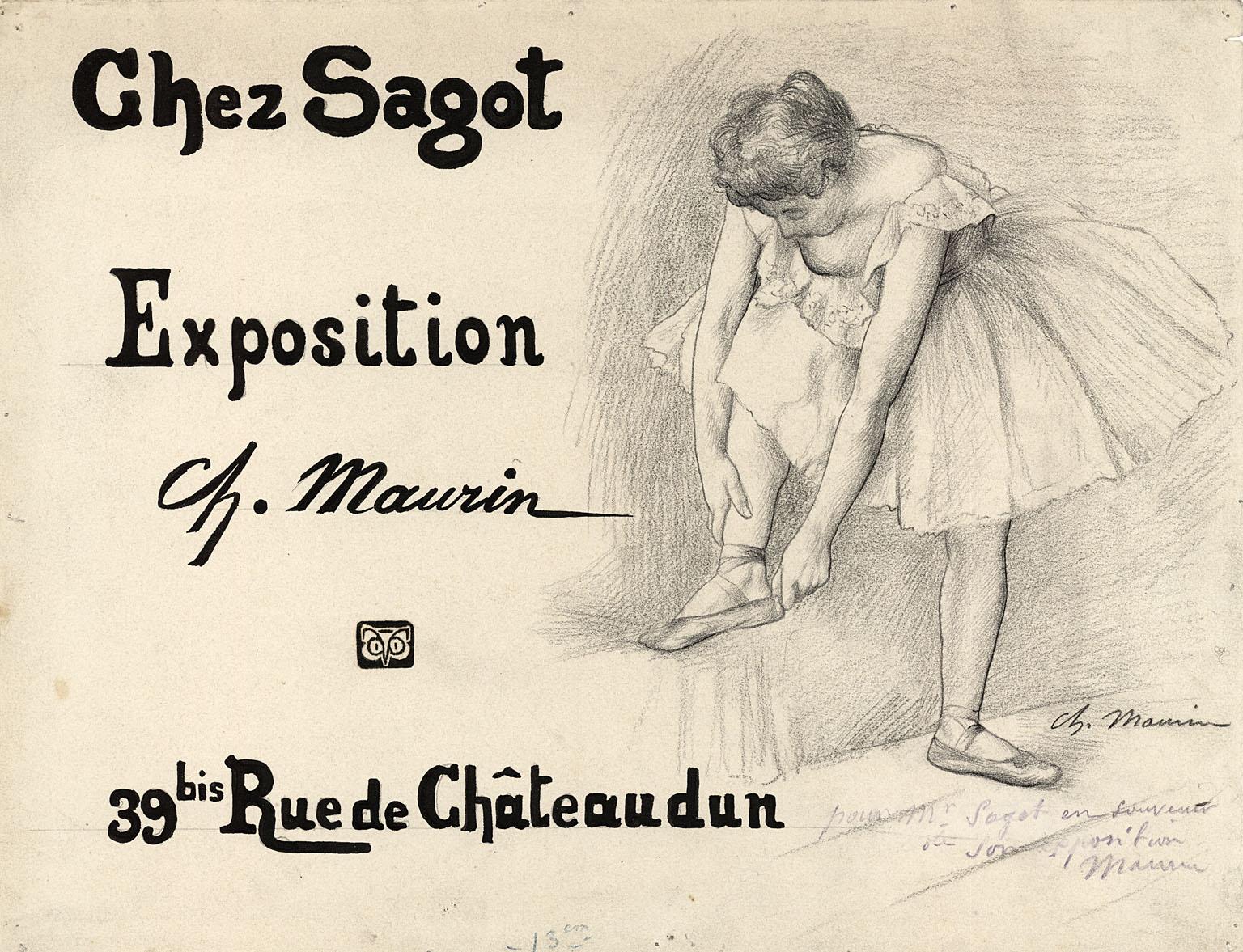Items Similar to Untitled (Standing man with umbrella behind)
Want more images or videos?
Request additional images or videos from the seller
1 of 5
Charles MaurinUntitled (Standing man with umbrella behind)c. 1890
c. 1890
About the Item
Untitled (Standing man with umbrella behind)
Graphite on paper, c. 1890's
Unsigned
Provenance: Estate of the Artist
Lucien Goldschmidt (1912-1992), noted art
dealer and scholar on Maurin
From the artist's sketchbook/record book, with the typeface number "561"
Image size: 7 7/8 x 6 1/4 inches
Condition: Good, tipped to support sheet
Charles Maurin
le puy-en-velay 1856 - grasse 1914
Biography
Having won the art scholarship known as the Prix Crozatier in 1875, Charles Maurin entered the Ecole des Beaux-Arts in Paris, studying with Jules Lefèbvre and Gustave Boulanger, and with Rodolphe Julian at the Académie Julian. He first exhibited at the Salon des Artistes Français in 1882, where he showed a pair of portraits, one of which gained an honourable mention. He continued to exhibit at the Salon des Artistes Français until 1890. He participated in the Salon des Indépendants for the first time in 1887, showing a number of paintings, drawings and engravings that were admired by, among others, Edgar Degas. As an artist, he worked in a variety of styles, the most distinctive being a sort of Symbolism evident in a range of allegorical subjects that he treated.
Maurin had a lifelong interest in the depiction of the female nude, and, like Degas and Mary Cassatt, was fond of portraying women at intimate moments of their daily routine. He also produced a handful of splendid portraits, mainly in the 1880s and 1890s, of friends, patrons and fellow artists including Georges Seurat and Rupert Carabin, as well as drawings and pastels of café, theatre and street scenes. Around 1885 he took up an appointment as a professor at the Académie Julian, where he met Félix Vallotton, who became a close friend. Another good friend was Henri de Toulouse-Lautrec, with whom Maurin shared an exhibition in 1893 at the Galerie Boussod et Valadon in Paris. It was there that, at the urging of Degas, the collector Henry Laurent began to acquire Maurin’s work, eventually becoming his foremost patron and collector.
The 1890s found Maurin enjoying a moderately successful career, with one-man shows with Ambroise Vollard in 1895 and at Edmond Sagot in 1899. He received a commission from the State for a painting of Maternité (Motherhood); completed in 1893 and sent to the museum in his native town of Le Puy, the painting was soon regarded as one of the artist’s finest works. The previous year he took part in the inaugural Salon de la Rose + Croix, where he showed one of his largest and most important paintings; a monumental triptych entitled L’Aurore (Dawn). He also contributed works to the Salons de la Rose + Croix of 1895 and 1897. Maurin painted a series of large decorative panels of Tragedy, Dance and Music for the foyer of the municipal theatre in Le Puy in 1893, and for Sarah Bernhardt designed sets and costumes for Edmond Rostand’s La Princess Lointaine in 1895. He visited Holland, Belgium and England, and sent works to Le Libre Esthétique in Brussels in 1896 and 1897, and the Exhibition of International Art in London in 1898. A man of firm anarchist leanings, Maurin produced illustrations for the radical journal Le Temps nouveau, and published portrait prints of the French anarchists Louise Michel and François Koenigstein, known as Ravachol. In 1895 he was also commissioned to provide illustrations for the art and literary journal La Revue Blanche.
After 1900, however, Maurin’s output declined considerably, partly due to ill health, and the last years of his life were spent in Brittany and Provence, where he died in obscurity in 1914. His work was largely forgotten after his death, although a retrospective exhibition was held at the Galerie Bernheim-Jeune in Paris in 1921, while a monograph on his work by Ulysse Rouchon was published the following year. Although a significant collection of Maurin’s work is today in the collection of the Musée Crozatier in Le Puy-en-Velay, his paintings and drawings remain little represented in museums outside France.
As a draughtsman, Charles Maurin was equally adept in pastel, chalk and pencil, and was highly regarded by critics, collectors and fellow artists; his drawings were, for example, particularly esteemed by Degas, who compared his draughtsmanship to that of his own great hero, Ingres. An innovative artist, he invented a method of using an atomizer to spray pigment onto the surface of the paper to create what he termed ‘peintures au vaporisateur’; large, atmospheric watercolour landscapes of great subtlety and beauty. Maurin is perhaps best known today, however, as a gifted and prolific printmaker, and played an important role in the revival of colour etching and wood engraving in the 1890s. Like his paintings, many of his prints focus on the female nude, or the theme of mothers and children, and account for some of the artist’s most striking and individual works. Maurin also developed a number of new techniques and processes, particularly with regard to printing in colour. Some of his prints were published in editions of ten or less, however, and much of his graphic work remains very rare today.
Although long forgotten or ignored after his death, Charles Maurin’s eclectic oeuvre as a painter, printmaker and draughtsman remains one of the most distinctive of any artist in France in the late 19th century. The French scholar Jacques Foucart, writing in 1979, succinctly described the artist as ‘that curious and libertarian figure, so typical of the effervescent Paris of the Belle Epoque, an engraver of social customs comparable with Louis Legrand, a perfectionist and an inventive technician, a sensitive draughtsman à la Besnard, a friend of Lautrec and Valloton. He created some of the most extravagant humanitarian and ‘socialist’ visions of the fin-de-siècle, which he treated in a flexible and decorative ‘graphisme’ in the manner of Eugène Grasset, or even of De Feure...That an artist of such intriguing qualities – even though, as engraver of nudes, he does at times become rather tiresomely vulgar and commercial – and so representative of a period that was hungry to explore everything (it is often said that all modern art was contained in the years before 1914), has been the subject of neither an exhibition, since that of 1921 at Bernheim’s, nor of a monograph, certainly sets one thinking about the vagaries of Taste and about the nature of the present fashion for the art of 1900.’ In recent years, however, a revival of interest in Maurin’s remarkable body of work culminated in a major monographic exhibition, entitled Charles Maurin, un Symboliste du Réel, at the Musée Crozatier in the artist’s native town of Le Puy-en-Valey in 2006.
Courtesy Stephen Ongpin, London
- Creator:Charles Maurin (1856 - 1914, French)
- Creation Year:c. 1890
- Dimensions:Height: 7.88 in (20.02 cm)Width: 6.25 in (15.88 cm)
- Medium:
- Movement & Style:
- Period:
- Condition:
- Gallery Location:Fairlawn, OH
- Reference Number:
About the Seller
5.0
Recognized Seller
These prestigious sellers are industry leaders and represent the highest echelon for item quality and design.
Platinum Seller
These expertly vetted sellers are 1stDibs' most experienced sellers and are rated highest by our customers.
Established in 1978
1stDibs seller since 2013
711 sales on 1stDibs
Typical response time: 1 hour
Associations
International Fine Print Dealers Association
- ShippingRetrieving quote...Ships From: Akron, OH
- Return PolicyA return for this item may be initiated within 10 days of delivery.
More From This SellerView All
- Femme nue de dos allongeeBy Théophile Alexandre SteinlenLocated in Fairlawn, OHFemme nue de dos allongee Charcoal and white chalk on laid paper Signed in charcoal, lower right "Steinlen" (see photo) Note: Similar reclining nude drawing illustrated Slatkin No. 12 (See window on right) Similar drawing, same model, same media, Proute 1971, Catalog Dandre Bardon, no. 115 There also other similar finished drawings of nudes in similar poses and with the same couch, white blanket...Category
1920s French School Nude Drawings and Watercolors
MaterialsChalk, Charcoal
- Woman with Bicycle: Two ViewsBy Frank DuveneckLocated in Fairlawn, OHWoman with Bicycle: Two Views Graphite on paper, c. 1890 Unsigned Graphite study of standing female nude verso Provenance: Rookwood Pottery Factory ...Category
1890s American Realist Figurative Drawings and Watercolors
MaterialsGraphite
- UntitledLocated in Fairlawn, OHBömmels belonged to the co-founders of the Cologne artist group Mülheimer Freiheit , which also included Hans Peter Adamski , Walter Dahn , Jiří Georg Dokoupil , Gerard Kever and Gerhard Naschberger . From 1979, the young artists shared a backyard studio in the street "Mülheimer Freiheit" in Cologne, which leads to the Rhine. In 1980 he co-founded the music magazine Spex . In 1983 he was awarded the Promotion Prize of the State of North Rhine-Westphalia for Fine Arts, In 1986 and 1987 he had a visiting professorship at the College of Fine Arts in Hamburg , from 1990 to 1992 at the then Hochschule der Künste Berlin , in 1996 at the Royal Danish Academy of Art in Copenhagen and from 2001 to 2002 at the Braunschweig Academy of Fine Arts . From 2004 to 2018 professor for painting at the HfBK Dresden . In 1993 he received the Fred Thieler...Category
1980s Surrealist Figurative Drawings and Watercolors
MaterialsGraphite
- Untitled (Woman working in the fields)By Daniel Ridgway KnightLocated in Fairlawn, OHUntitled (Woman working in the fields) Graphite on wove paper Unsigned Exhibited: Spanierman Galleries, In Praise of Women, Oct. 21-Nov. 20, 2010 Illustrated: Lisa N. Peters, In Praise of Women, Spanierman Galleries (see catalog entry in photos) Condition: Excellent Sheet size (sight): 14 1//2 x 10 5/16 inches Provenance: Spanierman Galleries, New York The young woman is a known model for Knight. She is depicted in numerous paintings. The striped skirt and wooden shoes she wears also is repeated in Knight's oeuvre. "Daniel Ridgway Knight was born in Philadelphia to a Quaker family and studied at the Pennsylvania Academy of the Fine Arts from 1858 to 1861, the year he became a founding member of the Philadelphia Sketch Club. He went to Paris and studied at the Ecole des Beaux-Arts from 1861 to 1863 with Charles Gleyre (1808-1874) and Alexandre Cabanel (1823-1889), and attended the Accademia di San Lucca, then in Venice, in 1863. Knight returned to Philadelphia that year, married, and served in the Union Army during the Civil War. He went back to France in 1871 and lived there for the remainder of his long and successful career. He settled in Seine-et-Oise near Poissy to study with the noted academic painter Jean-Louis-Ernest Meissonier (1815-1891) in 1873, and the two artists became close friends. Influenced by his French contemporaries Jules Bastien-Lepage (1848-1884) and Jules- Adolphe-Aimé-Louis Breton...Category
1890s Abstract Impressionist Figurative Drawings and Watercolors
MaterialsGraphite
- Untitled (Seated Young Woman)Located in Fairlawn, OHUntitled (Seated Young Woman) Graphite on Veritable Papier d'Arches wove paper, 1970 Signed and dated lower right (see photo) Condition: Excellent Image/sheet size: 15 x 11 1/4 inch...Category
1970s American Realist Figurative Drawings and Watercolors
MaterialsGraphite
- Reclining Female NudeBy Emil GansoLocated in Fairlawn, OHReclining Female Nude Charcoal on paper, c. 1933 Signed lower right (see photo) Provenance: Weyhe Gallery, New York (Ganso's dealer 1925-1941) Joseph Mark Erdelac, Cleveland, noted collector who had a large collection of Ganso works Ganso was born in Germany in 1895. At age 14, he apprenticed to a baker and then worked his way to America when he was 17. He worked in bakeries in Scranton, Pennsylvania; and Cincinnati and Akron, Ohio. By 1916, Ganso out of a job, and was living the life of a bohemian in New York City, sometimes on less than 30 cents a week.1 In 1921, Ganso painted a realistic nude on a bedsheet, and was forced by the police to remove it from an exhibition. The bedsheet with the painting was later stolen. He soon had a job baking again at $140 a month, and with time to spare for painting and study. Ganso quit baking in 1925 when a New York dealer gave him financial backing of $50 a week. Ganso prospered from his art after that. His work is in over 15 American museums, and the Print Club of Cleveland awarded him a $500 purchase prize for a wood engraving. A versatile artist, he painted a variety of subjects. (from a profile written by Clyde Singer...Category
1930s American Modern Nude Drawings and Watercolors
MaterialsGraphite
You May Also Like
- Rue de Thorigny, signed F. FeuilloyLocated in Middletown, NYGraphite and crayon in color with white heightening on cream wove paper, 13 1/2 x 12 1/4 inches (343 x 310 mm) (sheet). In good condition with uniform toning, handling creases, and lightly dog-eared corners. The building on the left is a hotel particulier in Paris' Marais neighborhood, the Hôtel Salé, which now houses the Musée Picasso.Category
Late 19th Century French School Landscape Drawings and Watercolors
MaterialsCrayon, Handmade Paper, Graphite
- Portrait of a Gentleman in a Redingote by student od Jean Louis David drawingLocated in Norwich, GBAn exceptional ink, wash and graphite portrait of a gentleman by Henri-Joseph Hesse, dating from circa 1820, the time of the Bourbon restoration in France. It depicts a dashing figur...Category
Early 19th Century French School Portrait Drawings and Watercolors
MaterialsPaper, Ink, Graphite
- Mountain landscape with an aqueduct and dam - FRENCH SCHOOLLocated in Middletown, NYPencil on smooth cream wove paper with a window pane drawn in gold ink, 8 3/8 x 11 3/4 inches (213 x 298 mm). Signed illegibly and dated in ink and again in pencil within the lower m...Category
Mid-19th Century French School Landscape Drawings and Watercolors
MaterialsGold
- Attributed to Eugene Deully (1866-1933) A sitting woman, study, drawingLocated in Paris, FRAttributed to Eugene Deully (1866-1933) A sitting woman, study, Pencil and heightenings of white gouache on blue grey paper; 23 x 14.5 cm Framed (damag...Category
1890s French School Figurative Drawings and Watercolors
MaterialsPencil
- Still life with ornamental urn, grapes and flora - French School 17 Cent.Located in Middletown, NYPencil on cream laid paper, 10 x 8 3/4 inches (254 x 222 mm). Uniform age tone, scattered surface soiling, and handling wear. One pea-sized area of skinning in the top-center sheet ...Category
Late 18th Century French School Still-life Drawings and Watercolors
MaterialsLaid Paper, Pencil
- Ballet Dancer, untitled drawing.By Charles MaurinLocated in New York, NYCHEZ SAGOT EXPOSITION CH. MAURIN 39 BIS RUE DE CHATEAUDUN. Signed pencil drawing with the artist's owl head' stamp circa 1899. Paper size 9 7/8 x 12 3/4" (25 x 32.6 cm). This orig...Category
Late 19th Century French School Figurative Drawings and Watercolors
MaterialsIndia Ink, Pencil
Recently Viewed
View AllMore Ways To Browse
Watercolour Of Venice
Grimm Book
D Barrett
Luis Quintanilla
Jehan Vibert
El Camino Real
Lanvin 1998
Al Hirschfeld Self Portrait
Royle Galleries
Vintage Santa Claus Drawings
Vintage Snowman Painting
Cornelia Fitzroy
Eduardo Guerra
Le Verne
Straw Bonnet
Russian Soviet Union And Cold War Propaganda Posters
Vintage Reindeer Drawing
Arthur Pina





